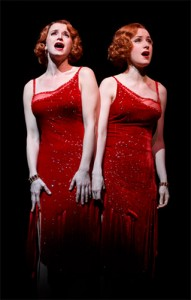Emily Padgett and Erin Davie aren't identical, not even close. But when they take the stage in
Side Show, it's easy to believe they're conjoined.
That's largely thanks to Charles G. LaPointe and Paul Tazewell, whose wig and costume designs (respectively) for the entire ensemble of this Broadway musical employ sophisticated theatrical illusions to convince us that the unusual people we're seeing are real.
Padgett and Davie play Daisy and Violet Hilton, twins born connected at the lower spine who became vaudeville stars in the 1930s. The musical charts their lives, and when it originally premiered on Broadway in 1997, original stars Alice Ripley and Emily Skinner simply stood close together. We were left to imagine them as two people sharing one body.
However, for the revival, which transfers to Broadway's St. James after playing the Kennedy Center earlier this year, director Bill Condon wanted a more naturalistic look. "He comes from the world of film and fully realizing a world," says Tazewell.
To that end, the twins need to be physically connected. The challenge for Tazewell is making sure they can "share a body" and still execute all the movement in the show. Though he stitched some of their garments together, he mostly unites the actresses with magnets that are hidden inside their garments. (It's a technique he's used before, sometimes to help a hat stay on an actor's head.)
"I thought this would be the best way to make it easier for the twins to deal with their quick changes," he says. "My thought was that it was always going to be much easier for them to individually be quick changed than it would be for them to quick change connected all the time."
The wigs are also made to look naturalistic. There are close to 50 in the show, some used very briefly, and all made of human hair. "They're all meant to resemble hair that's coming off the head as opposed to being an actual wig," LaPointe says. "From there we can style it into whatever we need to."
When the musical starts, Violet and Daisy are working in the titular side show, but they soon become older and more well-known in the vaudeville circuit. That change is clearly reflected in their costumes and wigs. "It was wonderful to create a visual arc for the twins and evolve them through time and as they emotionally and economically mature," Tazewell says.
At first, LaPointe planned to use Mary Pickford-style ringlets to make the twins look younger at the beginning, then change colors and styles as they acquired a fancier lifestyle. He had to adjust his plan, however, because of the differences in Padgett and Davie's facial features. Davie's face is rounder (she's also taller), and Padgett's is narrower with smaller features. "Someone can have a very strong opinion about the look that they want, but if it doesn't work on the person, you have to adjust it and make it work for them," LaPointe says.
The twins' wigs are now virtually identical, though the parts are on different sides. "The hair being the same color automatically pulls them together," LaPointe says. "And then keeping the styles similar also pulls them together. So you end up suspending your disbelief." He adds that the makeup---designed by Cookie Jordan---adds another crucial element to the illusion.
The team has used similar ingenuity for the other characters, including "freaks" like a Half Man/Half Woman (Kelvin Moon Loh), 3-Legged Man (Brandon Bieber), Dog Boy (Javier Ignacio), and Bearded Lady (Blair Ross). With a cast of 21, most of the actors double as ensemble, so they are constantly changing their looks.
For Tazewell, this meant creating an enormous amount of "underdressing," or costumes under costumes. The Lizard Man (Don Richard), for instance, wears his tight-fitting suit, made to look like skin, under most of his ensemble costumes.
All this theatrical sleight-of-hand is necessary, of course, to make us forget we're watching stage trickery and instead focus on the human stories beneath the lizards and the beards and the shared spines.
--
Linda Buchwald tweets about theatre as @PataphysicalSci
Photo by Andrew Eccles